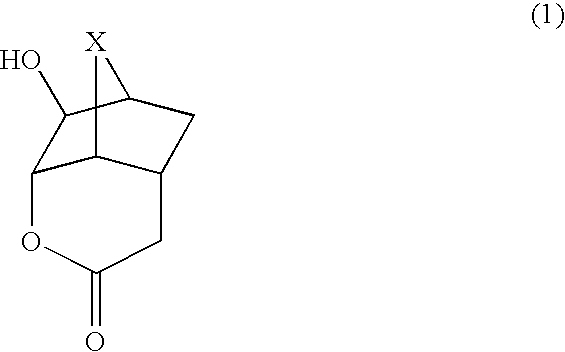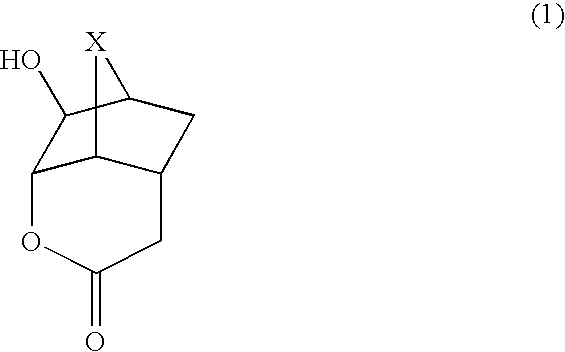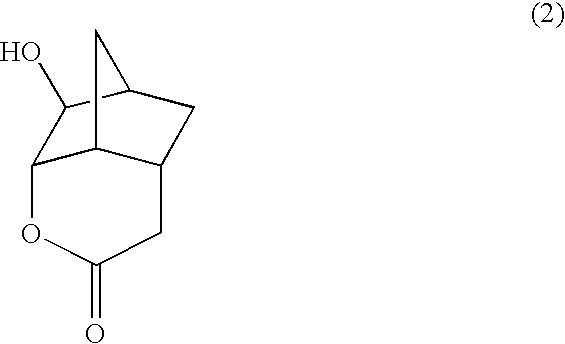Lactone compounds, lactone-containing monomers, their polymers, resist compositions using same, and processes for forming patterns using same
a technology of lactone and polymer, applied in the direction of auxillary/base layers of photosensitive materials, instruments, photosensitive materials, etc., can solve the problems of difficult development of monomers having substrate adhesion, difficult to make the reaction proceed homogeneously, and high molecular compounds not yet available for practical us
- Summary
- Abstract
- Description
- Claims
- Application Information
AI Technical Summary
Benefits of technology
Problems solved by technology
Method used
Image
Examples
example 1
[0087] The synthesis of a compound represented by the formula (2) was conducted by the following process.
[0088] A compound (10.52 g) represented by the formula (5), water (50 g) and ammonium hydrogencarbonate (8.53 g) were sequentially added to a four-necked flask equipped with a thermometer and a rotor. The internal temperature was set to 40° C., and 30% hydrogen peroxide aqueous solution (62.01 g) was added in a dropwise manner for 30 minutes, followed by stirring for 17 hours at that temperature. Magnesium hydrogensulfite was added to the reaction liquid to treat an excess of hydrogen peroxide, followed by adding to saturated sodium bicarbonate aqueous solution to make it basic. It was extracted with ethyl acetate, followed by washing with saturated brine, then drying with anhydrous magnesium sulfate, then filtration, and then concentration of the filtrate with an evaporator. Toluene was added to the residue, followed by recrystallization to obtain a compound (6.74 g, 66%) repr...
example 2
[0092] The synthesis of a compound represented by the formula (6) was conducted by the following process.
[0093] A compound (1.80 g) represented by the formula (2), toluene (18 mL), methacrylic acid anhydride (1.86 g) and methanesulfonic acid (0.10 g) were sequentially added to a four-necked flask equipped with a thermometer and a rotor, following by stirring for 6 hours at an internal temperature of 70° C. The reaction liquid was poured into saturated sodium bicarbonate aqueous solution, thereby making a two-layer separation. The organic layer was washed with saturated sodium bicarbonate aqueous solution and saturated brine, followed by drying with anhydrous magnesium sulfate, then filtration, then adding a polymerization inhibitor to the filtrate, and then concentration with an evaporator. Diisopropyl ether was added to the residue, followed by recrystallization to obtain a compound (1.52 g, 60%) represented by the formula (6). The identification data of the obtained compound are...
example 3
[0097] A polymerization of a compound represented by the formula (6) was conducted by the following process.
[0098] A compound (0.6 g) represented by the formula (6) was put into a flask equipped with a stirrer, and dimethyl 2,2′-azobis(2-methylpropionate) (trade name: V-601 of Wako Pure Chemical Industries, Ltd.) (4 mol %) as a polymerization initiator was added, and methyl ethyl ketone (400 wt %) as a polymerization solvent was added. This flask was heated in an oil bath of 75° C. to conduct the reaction for 16 hr. After the reaction, the reaction solution was introduced into n-hexane, followed by stirring. The resulting precipitate was filtered out, followed by vacuum drying at 50° C. for 10 hr. The composition of the obtained polymer was determined from 1H-NMR, and the molecular weight (Mn, Mw / Mn) was determined from GPC analysis (standard polystyrene). The results are shown in Table.
PUM
| Property | Measurement | Unit |
|---|---|---|
| width | aaaaa | aaaaa |
| carbon number | aaaaa | aaaaa |
| temperature | aaaaa | aaaaa |
Abstract
Description
Claims
Application Information
 Login to View More
Login to View More - R&D
- Intellectual Property
- Life Sciences
- Materials
- Tech Scout
- Unparalleled Data Quality
- Higher Quality Content
- 60% Fewer Hallucinations
Browse by: Latest US Patents, China's latest patents, Technical Efficacy Thesaurus, Application Domain, Technology Topic, Popular Technical Reports.
© 2025 PatSnap. All rights reserved.Legal|Privacy policy|Modern Slavery Act Transparency Statement|Sitemap|About US| Contact US: help@patsnap.com



